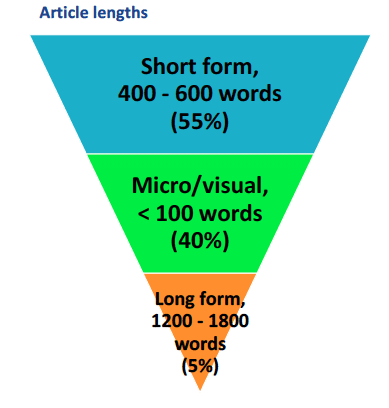
Find the right balance with a content mix
Content mix is all about proportions. Your research-based personas and audience messaging cards specify priority content considerations for your audience. The content you’ve mapped to your customer journey lays out which content your audience wants at which points of their experience with your company.
What’s missing is how much of each type of content. What’s the ratio of articles to infographics? Of topics for Sue to topics for Tom? This is what your content mix answers. It helps you find the right balance of different elements of content, taking into account your company strategy, audience needs, and available resources.
Creating a content mix is all about proportions. Click To TweetWhat you’ll need
Identify the company considerations that will inform your content mix. These may include:
- Business goals
- Industry expertise
- Brand focus
Gather your audience research and content tools. Pay special attention to audience goals and various content preferences, like topic, format, and channel.
Finally, clarify the resources you have available for creating and maintaining content. How many content contributors do you have? What are their skill sets? How much time do they have? Resources are key when defining content formats and your editorial schedule because you need to work with what’s possible for your team.
Identify your content elements
Your content elements will vary depending on your industry, audience, and overall content strategy. They may include:
- Topic. High-level subject area. For a furniture company, topics could be organized by rooms of the house: kitchen, bedroom, or outdoor furniture.
- Subtopic. Specific subject area. These get more granular: chairs, tables, beds, etc.
- Purpose. Your content can have many different purposes. Some of the most common examples are:
- To inform
- To teach
- To inspire
- To entertain
- To persuade
- Format. How content is presented: articles, videos, infographics, etc.
- Article length. A sub-element of format. Some articles might be 3 minute reads, others 10.
- Channel. Where content is published. Is it on your website? A social post? External blog?
- Audience. Which of your personas or audience cards your content is targeting.
- Brand focus. Which attributes of your brand the your content reinforces.
Decide on the most effective content mix and schedule
Finding the best content mix is all about proportions. You want to make sure you’re addressing all your audience needs in order of priority, while still aligning with your company’s strategy. And, of course, keeping your resources in mind.
Create a visual to represent the mix of each content element, like the examples below:

Once you have proportions for each content element, combine them in a table for an overall content mix.
Continually test and evaluate
Like most things content related, your first attempt can usually be improved. Always look for opportunities to gain insights into how your audience responds to your content. Applying metadata for each of the elements in the content mix makes it easier to track and see patterns of success. Remember you can change your content mix at any time to better reflect a new strategic direction or a new understanding of audience needs.
Further reading
From research to content tools: Online surveys

